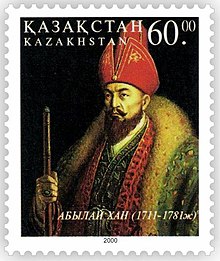Ablai Khan
This article needs additional citations for verification. (May 2023) |
| Abu'l-Mansur (Abylai) Khan Әбілмансұр (Абылай) хан أبو المنصور (أبيلي) خان | |||||
|---|---|---|---|---|---|
| Khan of the Three Kazakh Jüzes Khanzada Sultan Shah-i-Turan | |||||
 fantasy image on a postage stamp of Kazakhstan, 2000 | |||||
| Khan of the Kazakh Khanate | |||||
| Reign | 1771–1781 | ||||
| Coronation | 1771 | ||||
| Khan of the Middle Zhuz | |||||
| Reign | 1733/1743–1781 | ||||
| Predecessor | Abilmambet Khan | ||||
| Successor | Wali Khan | ||||
| Born | May 23, 1711[citation needed] Turkistan, Kazakh Khanate | ||||
| Died | May 23, 1781 (aged 70) Tashkent, Kazakh Khanate | ||||
| Spouse | Ruhani Daulet Begum | ||||
| Issue | Wali Khan Kasym Sultan Suyuk Sultan Adil Sultan (there were 30 sons in total) | ||||
| |||||
| House | House of Borjigin | ||||
| Dynasty | Tore House of Urus Khan | ||||
| Father | Korkem Wali Sultan | ||||
| Mother | Jazira Begum | ||||
| Religion | Sunni Islam | ||||
Wāli-ūllah Abū'l-Mansūr Khan (
romanized: Uäliūllah Äbılmansūr Han), better known as Abylai Khan or Ablai Khan (May 23[citation needed], 1711 — May 23, 1781) was Khan of the Middle Jüz (central region) was the last independent Kazakh Khan of the Kazakh Khanate
before the Khanate was absorbed into the Russian Empire.
Life
Born as Wali-ullah Abu'l-Mansur Khan, Abylai Khan belonged to the senior branch of descendants of the 15th century founder of the Kazakh state,
Kazakh title Shah-i-Turan (Persian for "King of Turan"). He was the last ruler of the Kazakh Khanate
to hold this honorific title since the khanate collapsed shortly after his death.
Although Ablai swore loyalty to the Russian tsarina in 1740 at
Middle jüz
Kazybek biy and Kanai biy, Abylai was elected as the Kazakh khan. He extended his power to significant areas of the Senior and Junior jüzes, considering himself the khan of all three jüzes.
The
Russian Empress requested that the title of khan should be recognized and officially approved by Russia. To that end, she sent an official letter to Qyzyljar, where Abylai was expected to receive the title in 1779. He never showed up at the fort, so a Russian officer was sent to confer the title in his camp. In contrast to Ablai, other khans and sultans had been competing for the lavish gifts and stipends of the Emperors of Russia in return for their submission. Ablai Khan refused to bow down to the expanding Russian Empire and instead chose to strengthen the Kazakhs by promoting Islam and the concept of jihad throughout the state as an effort to resist foreign powers. Ablai may also have been deterred from swearing his oath out of fear of insulting the Chinese.[3]
During the
Dzungars, Ablai Khan chose not to take sides. He sheltered the Dzungar Oirat taishis Amursana and Dawachi from attacks by the Khoshut-Orait King of Tibet, Lha-bzang Khan, as the Dzungar Khanate fractured following the death of Galdan Tseren in 1745. However, once Amursana and Dawachi were no longer allies, Ablai Khan took the opportunity to capture herds and territory from the Dzungars.[4]
During Amursana's rebellion against the Qing in 1755-56, Ablai Khan offered him sanctuary at one point and refused to hand him over despite the threat of a raid on his territory. However, by 1757, Ablai Khan had acknowledged Chinese suzerainty.Hazrat-e Turkestan.
Following his death, Ablai's sons, namely Khanzada Wali Sultan, Khanzada Qasim Sultan, and Khanzada Adil Sultan, fought against each other to take the throne. In 1781, Wali Sultan became was named
Middle jüz.[3]
Legacy
- One of his descendants was Shoqan Walikhanov (1835-1865), a Kazakh scholar and historian.
- His grandson Kenesary Kasymovled a revolt against the Russians in the 1830s and 40s.
- Abylai Khan University, founded in 1941, is named after Ablai Khan.
- In 1993, Ablai Khan appeared on the 100 Kazakh tenge banknote.[6]
- The life of Ablai Khan is the subject of the 2005 Kazakhstani film Nomad.
- There is a ceremonial slow march in the Military Band Service named after Ablai Khan
- A street in central Almaty is named after Ablai Khan.
- Abylai Khan (monument)
See also
- List of Kazakh khans
- Kenesary Khan
References
- ^ "«Тарих» - История Казахстана - школьникам | Исторические вехи | Средневековый Казахстан (VII – XVIII в.в.) | Исторические личности | Абылай, султан среднего жуза, а впоследствии Хан всех трех жузов (годы правления: 1771–1780 гг.)". Archived from the original on 2020-09-18. Retrieved 2019-10-27.
- ^ Olcott, Martha (1995). "The Russian Conquest". The Kazakhs. Hoover Institution Press. p. 40.
- ^ a b c Olcott, Martha (1995). "The Russian Conquest". The Kazakhs. Hoover Institution Press. pp. 42–3.
- ISBN 978-0-674-04202-5.
- ^ Hummel, Arthur W. Sr., ed. (1943). . Eminent Chinese of the Ch'ing Period. United States Government Printing Office. p. 10.
- ^ "P-13". www.banknote.ws. Retrieved 2023-05-26.
Sources
- Alexei I. Levshin, Opisanie kirgiz-kazach’ikh ili kirgiz-kaisatskikh ord i stepei (St. Petersburg,. 1832).
- "Famous Kazakhs". Archived from the original on 2007-12-21. Retrieved 2006-09-26. Website on the Kazakh Diaspora
- History of Kazakhstan to 1700 Encyclopædia Britannica Online.
